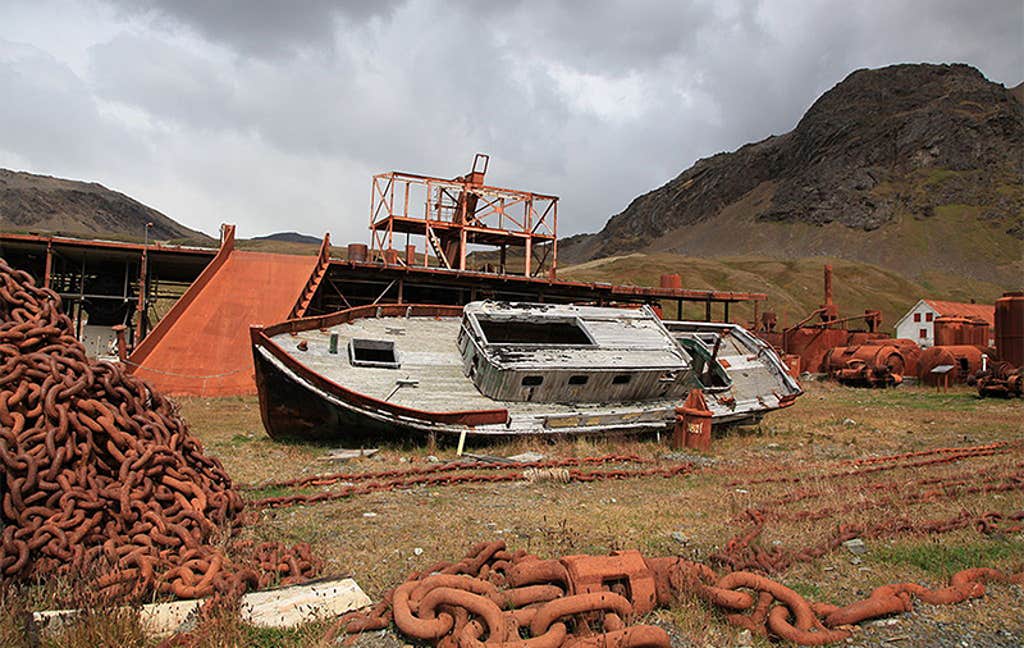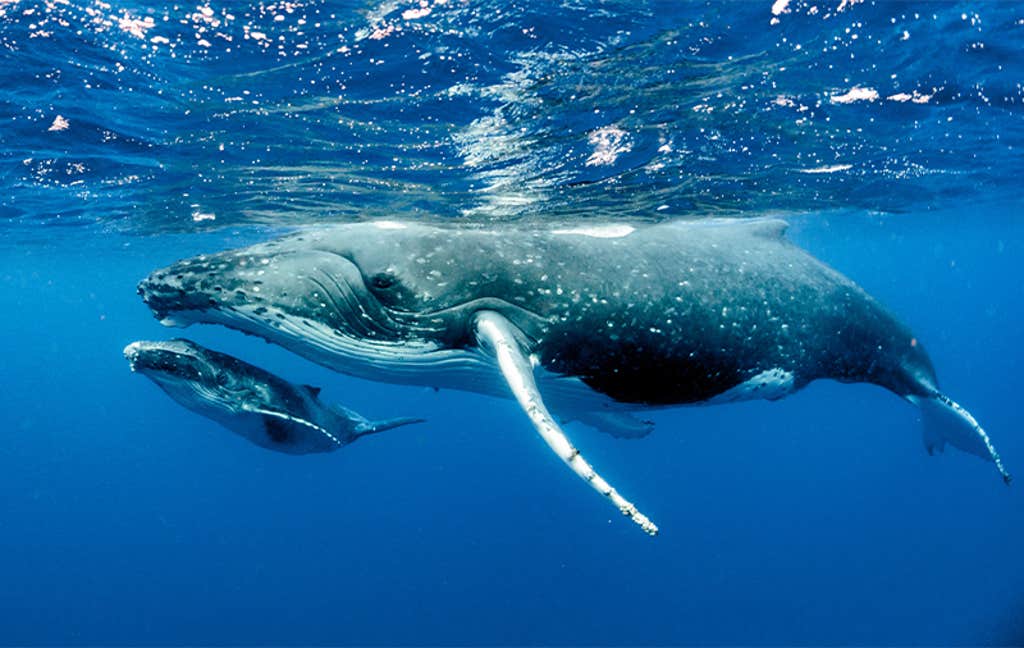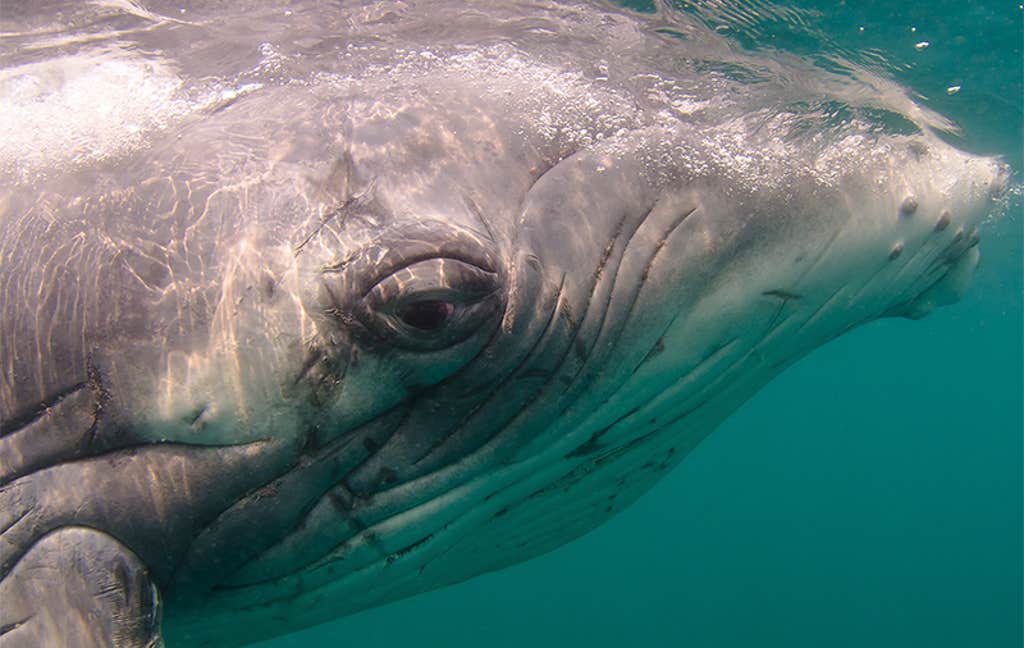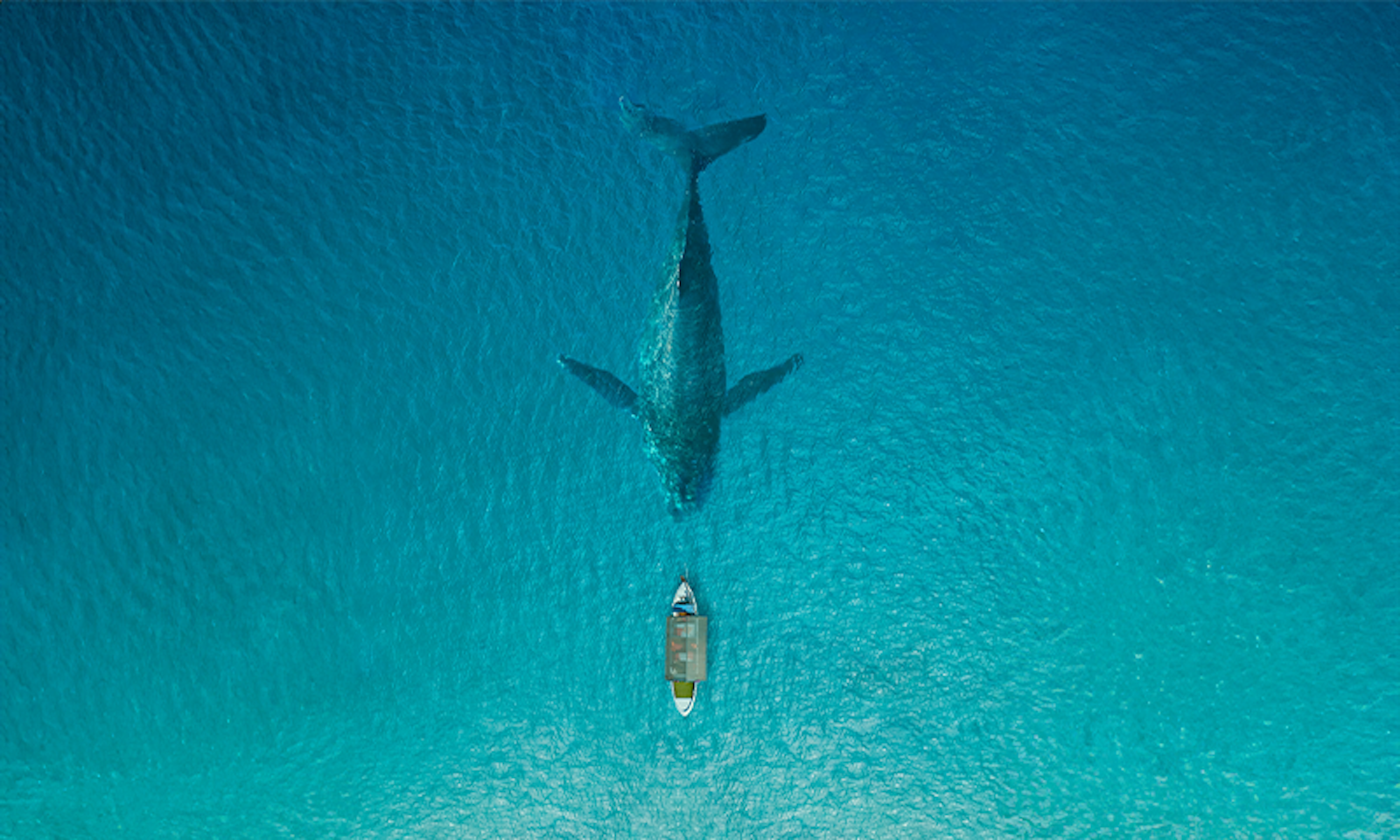The snow is falling slowly as I stand in the ruins of a huge, rusting blubber cookery. I look up as the flakes drift down. Do they contain molecules from the bodies of some of the blue whales who were boiled up in this landscape over half a century ago?
This is Grytviken, a former whaling station on the sub-Antarctic island of South Georgia. It is 2007 and I am here with the British Antarctic Survey to study the history of whaling, our species’ first boom-and-bust oil industry. At its peak, around 3,000 blue whales were killed each year in these waters, driving the populations to near extinction. If you read official documents from this era, individual whales are described simply as “units.”
How is it that I matter more than all those vast, magnificent whales in the sea?
What staggers is the sheer scale of the machinery these killings necessitated. The landscape itself is all contrast—dark, snarly rock, striped bands of brilliant cloud and blue sky, and the assault of light coming off the snow and ice. But the industrial history here takes your breath away. I find myself standing on a mortuary platform—a single, human female around five and a half feet tall on a slab of rusting metal around 80 feet in length. The difference between my slight form and the enormity of a whale’s proportions has never felt so striking. It was here that the whales were laid out to be cut up and rendered down for the oil that once lit London’s streets or lubricated textile machines. It was here their tongues were sliced out, their bellies and wombs split open and emptied.
Despite all I share with whales as a fellow mammal—my eyes, my brain, my lips, my heart—my small body has the greater power. And I found myself asking as I stood there that day: How is it that I matter more than all those vast, magnificent whales in the sea? I will spend much of the coming decade of my life occupied by this question.
Most modern societies are built on the idea that all humans have an inviolable moral status. Sadly, they don’t always hold to it, but the principle is there. Yet what grounds this status is contested: Some people argue that it is our unique mental powers, while for others, it is our morality. For others still, it is our souls. Since World War II, many have argued that respect for human dignity is at the foundation: a promise to stand in equality as fellow humans, members of that lonely species Homo sapiens. Without this moral standing, there would be no human rights or legal protections. We must be thankful.
Yet the participants in the various emancipation movements of the late 19th and early 20th centuries understood that something more than moral status was necessary. To count and be recognized in societies of unequally distributed power, people also needed to be heard in decision-making arenas. As such, workers, women, and people of color in western democracies all fought for the right to have a voice.
That work continues today. From political offices to boards of directors to arts committees to trade unions to political parties, people from historically marginalized communities continue their push to be fairly represented in places where decisions are made. And, as ever more people come to recognize the intrinsic moral status of animals, the next step is to give them a voice, too.
Cetaceans—that is, whales, dolphins, and porpoises—are perfect candidates for this. In 2010, The Helsinki Group, a gathering of eminent scientists and ethicists, argued that all cetaceans possess highly complex capacities that qualify them as persons. They play and work together and, in some cases, name one another. They experience pleasure and pain. They play tricks. Many have complex forms of communication, from clicks to “songs.”
Yet even as the era of commercial whaling is over, the threats to their lives have increased in other ways. Some cultures continue to slaughter whales and dolphins; ship strikes kill more than 20,000 whales each year. People willfully dump pollutants into the ocean, and nearly half of all marine mammals and seabirds become tangled in or ingest marine debris. Climate change will likely deprive many cetaceans of food and impair their reproduction, as well as increasing the incidence of infectious diseases.

Liam Quinn / Wikimedia Commons.
If we want to reverse these trends, we need to make two essential moves. The first is to give other species formal status in law and acknowledge that regarding animals like whales as resources is a violation of their dignity. The second is to recognize the other beings around us as subjects whose voices should be heard before we make decisions that will affect them.
But how do we include the perspectives of non-humans like whales in our decision-making?
Among human nations, when someone can’t be present in person for a decision that affects their life, we require an unbiased advocate or intermediary. Something similar is necessary if animals’ interests are to be heard. But how can we be sure that we know what other animals want? We can be confident that no animal wants to be harmed, coerced, or killed; and there are ways of scientifically assessing subtler aspects of animal intelligence and well-being, of understanding what they do and what matters in their lives. One example comes from neuroscientist Lori Marino and behavioral ecologist Toni Frohoff’s scientific work with cetaceans, which respects the individual cetacean’s ability to express their interests and autonomy.
Some scientists even want to use artificial intelligence to decode the communications of other animals, particularly cetaceans. Endeavors like the Earth Species Project and Project CETI, as detailed in the book How to Speak Whale, propose that technologies might allow us to directly “hear” what other animals want. This is heady stuff, although it comes with some caveats. In focusing on correlates of human language, we may exclude other, more important signals of what truly matters to another living being.
But whatever approaches we use to understand other animals, there is a further, crucial step. The evidence and testimony must be presented appropriately to gain a fair hearing. This is where new advances from deliberative democracy come in. A fundament of deliberation is to formalize listening to one another to capture crucial insights into the needs and interests of individuals and embed these deeper perspectives in policy and law. Deliberative methods include citizens’ juries and dialogues, where a small, diverse group of individuals from a community enter into conversation together over a period of time to try and find a shared solution to a problem or conflict. These kinds of deliberations are increasingly important in setting the direction for and legitimizing policy change.

Imagine, for example, that a decision must be made about a deep-sea mine. This kind of extractive technology produces sounds that can interfere with the communications between whales, generating stress and disrupting natural patterns of behavior. At present, deliberations might take place within a body like the International Seabed Authority (ISA). But what if the ISA had to commission a citizen’s jury that included the voices of the whales themselves as stakeholders?
In deliberations among humans, prior perspective-taking is important, especially where there are conflicting points of view, so that we are open to listening in the first place. But to take the perspective of another species, we might need more creative ways of embodying and empathizing. This is where the arts may prove a powerful ally. Theater, visual arts, film, and literature have long understood the potential of immersion in a different viewpoint to shake us out of our biases. And so, when we experiment with including other species in our decision-making, we may need methods from theater or performance to break through the barriers to considering and valuing non-human perspectives.
Still, many might ask: What is wrong with the status quo? Despite legislation to protect biodiversity and animal welfare, threats to other species are increasing. And climate change sets the stage for colossal future impacts on the lives of other species. In the absence of meaningful structural change, human interests will continue to override those of other beings.
Consider the High Seas Treaty, which was agreed upon earlier this year after 20 years of deliberation among United Nations member states. It allows for the creation of Marine Protected Areas in ocean regions beyond national control. This was seen as a victory for conservation—and yet the treaty is still couched in the language of human exceptionalism, in which some animals are considered as “genetic stock” rather than as beings with a unique world. This is hardly surprising. In the 20 years it took to arrive at the Treaty there was no serious attempt to include the animals themselves in the process. Whenever we persist in regarding other species as interchangeable units rather than as purposeful beings, we perpetuate systems of extraction and injustice, even while we seek to advance conservation.
What if we had to commission a citizen’s jury that included the voices of the whales?
A more recent approach taken by the “rights of nature” movement is to protect aggregates such as natural features and ecosystems by making them legal persons, not so different—in legal terms—from a human being. The rights of nature approach is potentially more powerful than conventional environmental laws. Rather than asking whether a proposed activity violates an existing law, a coral reef’s defenders, for example, can ask whether it violates the reef’s flourishing—and rather than depending on the state to take action, they have legal standing to make a case themselves, as representatives of the reef.
Yet rights of this kind are still an indirect form of protection, distinct from our individual rights. As political philosopher Alasdair Cochrane notes, the onus remains on us to acknowledge that individual animals and communities of other species might have interests beyond the perceived flourishing of an ecosystem. As such, says Cochrane, in a just society “animals must have their perspectives sought out, understood, and fed into decision-making in equitable terms.”
Of course, implicit in any approach that respects other animals as subjects of justice is the move away from attitudes that prioritize only those animals that are most like us. Why should only large mammals like whales be represented? What of octopuses, or any of the thousands of different kinds of fishes, or even colonial animals like siphonophores? From a truly respectful orientation, who deserves a hearing? Are there some species we’re more willing to listen to than others? These are essential questions as we move forward.
This year saw the launch of a project in which I’m involved called Animals in the Room, the experimental arm of a wider project on the democratic inclusion of animals and nature. Animals in the Room brings together philosophers, scientists, animal welfare specialists, artists, and communities to devise and test ways of including non-human animals in human decision-making. And we practice what we preach. One of the cornerstones of the work is that we, too, should listen to the animals in question, rather than present ourselves as experts.
Our first project—the first formal work of this kind and on this scale—will be undertaken in Europe with bears and the human communities who live alongside them. As to whales, we are already in the early stages of thinking through how we might represent the voices of our giant, less visible dwellers, out there in the world’s oceans.

When I stood in the ruins of the whaling industry in Grytviken all those years ago, my head was full of the diaries and letters of whalers from Europe who traveled thousands of miles to this unforgiving place. The young men wrote of their astonishment at the frozen landscape. They wrote of the stink and foul mechanics of sawing up an animal 10 times the length of one man. But they also expressed their regret. As the maritime artist Willem van der Does observed from a whaling ship, “The death struggle of this enormous animal was dreadful to behold. His unbelievable dimensions notwithstanding, he was in fact completely defenseless. Involuntarily the men felt a deep sympathy for these gentle giants when they were finished off so mercilessly.”
This regret was the result of their direct experience of the whales. The whales communicated their will to live, their attempts to assert their freedom. And, in those moments, the whalers no longer saw the whales as “units,” but as other beings.
When we truly pay attention to the life around us, we find that much of the Earth’s other beings do not conform to our imaginaries. Whales and dolphins are not “resources” in an ecosystem or genetic stock within the Earth’s “biodiversity,” or fixtures within a human idea of “nature.” They are beings who can and do determine for themselves who they are and what matters to their future. It should be their right to do so.
And so, when we come to protect the seas, we need to ask ourselves: Who should we see reflected in our decisions? Our own faces, glasslike on the waters of the world’s seas, or the faces of other beings rising up through the dark layers to meet us. ![]()
Lead image: Yalcin Sonat / Shutterstock


































